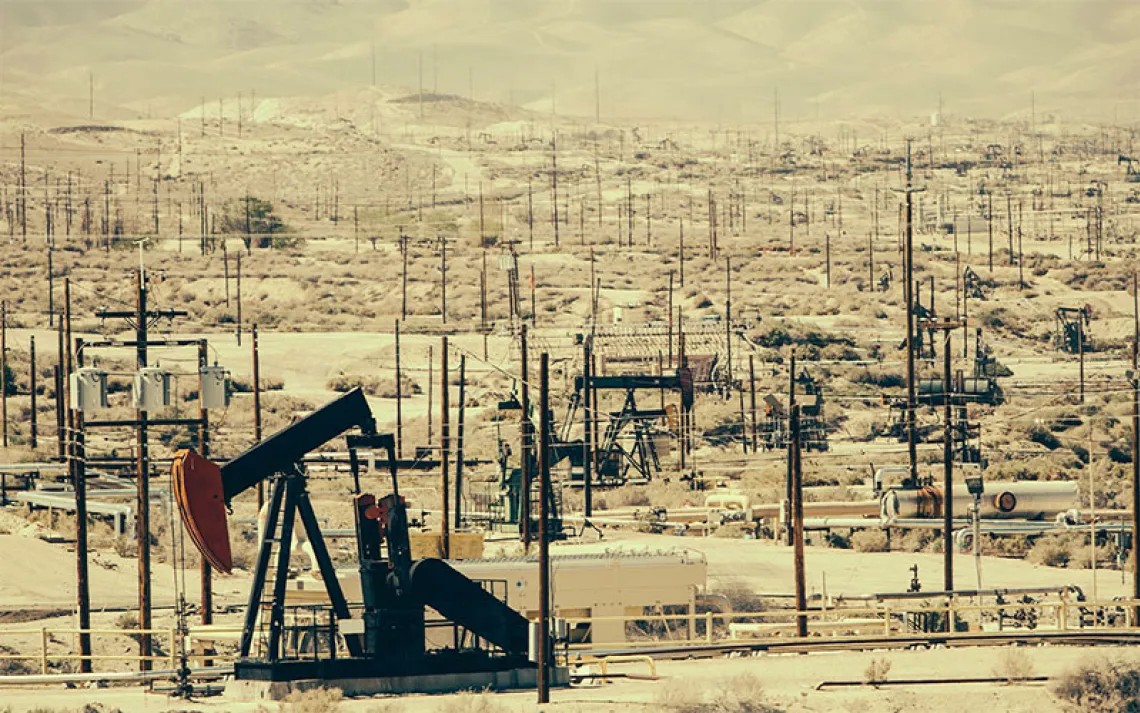Getting Off Gas, Block by Block
Trying to electrify a home can be hard. What if we instead focused on liberating entire neighborhoods from their reliance on methane gas?

A FEW YEARS AGO, Pacific Gas & Electric called Scott Hawkins with an unusual request: The giant California utility wanted to sever his gas service. Hawkins is the owner of an engineering firm in Moss Landing, California, and the utility was looking to avoid replacing the dodgy natural gas main serving that rural stretch of the central California coast. PG&E representatives said they would carry some of the costs of transitioning his office to being all-electric. “They said, ‘We’d like to cut you off from gas. Would you be OK with that? We’ll compensate you,’” Hawkins recalls.
Hawkins haggled and ultimately accepted $125,000—enough for a heat pump to replace the office’s gas furnace, plus an electric water heater and solar panels to supply some of the extra electricity the business would need. Hawkins says he had no objections to continuing to use methane gas, but he couldn’t see PG&E digging up a 2,000-foot stretch of highway and disrupting traffic for months only to serve his business. Going electric, he says, “just made sense.”
That rather unconventional move made big financial sense for the utility and its customers across Northern California. Avoiding a big dig under Highway 1 saved PG&E more than $1 million in costs—costs that the utility eventually would have passed on to ratepayers.
The Moss Landing gas pipe retirement was extremely unusual; it was one of perhaps 100 such “strategic decommissioning” projects that have taken place across the United States in recent years. Instead of shutting down dodgy pipes—and in doing so, helping to accelerate the transition to a clean energy economy—many utilities are replacing old pipes with new pipes at a frightening pace. In the process, they are further entrenching a fossil energy system that needs to cease operating within a few decades in order to stabilize global temperature rise.
But change is afoot. Regulators in a small but growing number of states are mandating that gas providers think about where it makes sense to start unwinding their gas networks. Northern California has become the epicenter of a series of experiments exploring how to take one-offs like PG&E’s Moss Landing project and scale them up. The hope is that a wave of gas decommissioning can create a financial swell for electrification that frees hundreds of homes and businesses at a time from gas.
The stakes are high. Buildings account for about 30 percent of US greenhouse gas emissions, owing to carbon dioxide pollution from gas furnaces and stovetops and leaks of potent, heat-trapping methane. Burning gas indoors is also linked to a slew of negative health impacts, including asthma and heart disease. Some residents worry about gas explosions, such as the pipeline blast that killed eight people near San Francisco in 2010.
While it’s possible for individual homeowners to disconnect from gas service, it’s complicated, time-consuming, and expensive. Only the most climate-concerned and determined households will undertake such an endeavor. A systematic approach is likely to be faster and cheaper than the home-by-home slog by which communities are slowly electrifying today. The potential is huge: Strategic decommissioning could eliminate half of gas pipe replacements through 2040, according to one analysis. That would reduce gas system costs by $100 million a year in the early days and save over $2 billion annually by 2045.

The obstacles confronting strategic decommissioning, however, are daunting. Converting entire neighborhoods from gas to electric still means getting individual customer buy-in, and that requires many hours of education and trust building. Also, state rules make it hard for utilities to profit from pipe-killing investments. Gas decommissioning “is an incredibly difficult problem from all kinds of angles—money, social, political, technical,” says Matthew Tisdale, executive director for Gridworks, a nonprofit utility reform group based in Oakland, California. “There are hurdles and barriers in every direction.”
Then there’s the coming financial hangover from installing new pipes designed to operate for half a century or more—something that would have devastating implications for energy justice. As affluent households, aided by increasingly generous state and federal incentives, go all-electric, more disadvantaged customers are at risk of being left behind and having to cover the full cost of maintaining gas grids. Utility rates will explode.
“Every time we put a new natural gas pipe in the ground . . . we’re knowingly putting a financial time bomb in the ground,” says Panama Bartholomy, who runs the Building Decarbonization Coalition. “There’s an old adage that if you want to get out of the hole, the first thing you do is stop digging it. Every mile of pipe we put in the ground just digs our hole deeper.”
ONE OF THE MAIN characters in today’s gas grid drama is a plastic called Aldyl-A. Gas companies installed thousands of miles of Aldyl-A gas pipes before devastating—and still ongoing—accidents revealed their propensity for cracking. A federal investigation blamed gas leaking from an Aldyl-A pipe for the destruction of the R.M. Palmer Company chocolate factory in Pennsylvania that killed seven people last year.
Driven by the Aldyl-A threat, as well as problems with corroding steel and iron pipes, state regulators have empowered gas utilities to dramatically ramp up investments in pipes. “There are four alternatives if you have a leaking pipe: replace, repair, retire, or wait,” says Mark LeBel, a utilities expert with the nonprofit Regulatory Assistance Project. “Until now, it’s been replace, replace, replace.”
The Michigan utility Consumers Energy, for example, expects to spend $11 billion on its gas network through 2030 even though it projects declining gas consumption. The utility’s spending on the upgrades could boost the average monthly bill from about $75 in 2021 to as much as $131 by 2030, according to an analysis by a clean energy trade group. If wholesale methane gas costs rise, the consumer bill increase would be even higher.
PG&E started thinking about another way forward over five years ago, prodded by economic and political pressures that have just kept mounting. California’s energy planners and regulators recently affirmed that hitting the state’s climate targets will require “a monumental shift away” from gas. “It was a really big statement from the state, politically, when they finally released that [report],” Bartholomy says.
In 2018, PG&E launched its Alternative Energy Program to identify locations where it could make a buck by capping gas pipes. The program is powered by proprietary mapping software that crunches data on everything, from the state of pipelines and power lines, to environmental risks, to local customers’ energy use patterns. An analysis of this data allowed the utility to identify 138 sites that held high potential for accomplishing two goals at once: saving the utility money while also assisting disadvantaged communities.
Meanwhile, a handful of utilities in other states with aggressive climate goals, including New York and Washington, are also starting to retire pipes. In each case, however, gas decommissioning projects have electrified just a handful of customers. Their tiny scale highlights the top challenge of gas shutoffs: getting customers to sign on.
Gas utilities’ monopoly franchises generally require that they keep delivering their fossil fuel as long as customers keep paying. That means a single gas user can sink a project, and, so far, one or more usually do. In 2021, for example, a farmer reported a leaky gas pipe south of Sacramento to PG&E. According to the utility, electrification could have saved ratepayers “millions on repairs.” Instead, the project died when the lone customer served by the 3.5-mile pipe insisted on keeping gas service.
IN PRACTICE, trying to decommission a gas line is a lot like trying to secure a guilty verdict in a jury trial: Every person has to say yes. Complete consensus is required to get every home on a block to go all-electric. And in a fractured, democratic society, consensus is hard to come by. A few gas decommissioning efforts in California’s Alameda County, on the east side of San Francisco Bay, illustrate exactly how hard it is, even in a politically progressive area.
Compared with PG&E’s total service area, Alameda County has a disproportionately high number of failing Aldyl-A pipes, meaning that there are plenty of prospects for pruning gas lines. Alameda County’s first gas-to-electric push grew out of the EcoBlock—an urban design experiment hatched in 2005 at the University of California, Berkeley, to see how neighbors could accelerate sustainability by acting collectively. In 2020, EcoBlock researchers partnered with the City of Oakland to put their ideas into practice, soliciting residents who would nominate their blocks to be guinea pigs in exchange for free energy upgrades.
EcoBlock project co-lead Therese Peffer, an affiliate researcher for UC Berkeley’s Center for the Built Environment, says they went with a cul-de-sac in Oakland’s Fruitvale district because PG&E saw its dead-end gas main as easy to cap without disrupting surrounding blocks. Retiring a gas line also interested Oakland, which plans to get all city buildings off gas by 2040. And Peffer says the university team had a hunch that a cul-de-sac would be more socially cohesive, enhancing chances for getting everyone on board.

Alas, after months of community meetings and public education events on advances in electric appliances like heat pumps and induction stoves, the Eco-Block’s homeowners in Oakland fell short of consensus. When construction on the $8 million project wraps this coming winter, a majority of its 45 homes will be all-electric, with solar panels spanning rooftops and a dedicated solar-fueled electric vehicle charging station. But gas will still flow down the street.
One EcoBlock holdout declined to participate for fear that inspectors would flag illegal upgrades inside their house. Others balked at the proposed elimination of natural gas. One homeowner told the local NPR station that they were unable to imagine “not cooking on gas.”
Getting off gas was a plus for Florequel Balaoing, who signed up the EcoBlock house that he and his wife, Annie, rent out. The Balaoings ditched gas heat and cooking at their own home because it gave Annie headaches, and they plan to add solar panels there. “I’m a big proponent of green technology,” he says.
But Florequel doesn’t begrudge the holdouts for keeping gas on the EcoBlock, calling it a personal choice. “It’s a different reason for everybody,” he says. “For some people, it’s about health. Some think it’s more economical.”
A second East Bay research project that wrapped up earlier this year showed what a slog it can be to reach homeowners and residents just to talk about getting off gas. The effort, coordinated by Gridworks, examined the prospects for decommissioning whole neighborhoods at a time by studying the hypothetical electrification of several 100-to-200-home areas in Oakland and nearby cities Hayward and San Leandro. Despite offers of $150 stipends, free food, and childcare, focus groups organized by local environmental-justice consultants to gauge residents’ interest and concerns were less than half full. Those who did attend expressed a wide range of concerns, including worries about rising electricity rates and more frequent blackouts.
“Humbling,” is how outreach coordinator Helen Mejia Perez describes engaging with the study zones. Ultimately, the research concluded that ending gas service at neighborhood scale could avoid roughly half of gas line replacements that will otherwise occur over the next 20 years while saving residents money. But the team figures it could take a decade to overcome residents’ concerns.
Their recommendation for future efforts: Stick with single-block projects and hone the messaging before trying to scale up. That’s exactly what’s happening in a third decommissioning project underway in the small, densely packed city of Albany, located north of Berkeley. A $200,000 grant from the US Department of Energy is funding two years of intensive door-to-door consultations that the city hopes will ultimately convince at least one block to give up gas. But Albany’s city council instructed staff to prioritize lessons for organizers over actual decommissioning. As a result, outreach will target areas where gas shutoffs may have the greatest potential to address environmental and energy inequities but where consensus may be hardest to achieve: blocks with lots of renters in multifamily apartment buildings.
As Albany vice mayor Robin López put it at a city council meeting in May, “The idea of decommissioning one city block sounds amazing . . . sounds inspiring. But what’s most important is learning how we help our whole community move forward.”
THE NORTHERN CALIFORNIA PROJECT with the best hope of shutting off a lot of gas all at once targets several hundred buildings owned by a single, environmentally motivated entity: California State University, Monterey Bay. The campus occupies a former army base perched atop coastal dunes, about a 20-minute drive down Highway 1 from Moss Landing. There, PG&E is poised to lop off entire branches of the campus’s gas grid in what could be one of the world’s biggest acts of decommissioning.
PG&E years ago flagged Cal State Monterey’s Alkyl-A pipes for replacement, citing “observed fusion failures” (a.k.a. weak connections) and “possible loss of containment events” (a.k.a. gas leaks). Then PG&E saw an opportunity to demonstrate the benefits of decommissioning by electrifying one zone of the university’s housing en masse. The utility figures that removing the Frederick Park development’s 32,000 feet of gas pipes and equipping its 600 homes with electric furnaces, stoves, water heaters, and clothes dryers would cost $14.4 million. Sounds like a lot, but that’s $1 million less than the utility would spend to sustain gas service. Removing gas appliances would also eliminate the amount of carbon emissions equivalent to taking nearly 500 gasoline-powered cars off the road for a year.
Cal State Monterey’s former sustainability director once called the proposal a no-brainer, saying that adding new gas equipment in the 2020s would be “like buying a fax machine in 1999.” But outmoded infrastructure nearly won the day after a change in campus leadership. Shortly after PG&E filed for expedited approval from the California Public Utilities Commission (CPUC), citing the campus pipes’ condition, negotiations between the utility and university over project details stalled. For a time, it looked like the utility’s obligation to supply gas might torpedo an ideal opportunity—until the parties finally clinched a deal in June.
But the pilot project still has to overcome gas decommissioning’s other major hurdle: aligning the utility’s profit motive with commonsense economics. Even though electrification is almost always cheaper than gas pipe replacement, the rules that govern how investor-owned utilities earn a profit create a perverse incentive to keep digging.
Agencies like the CPUC assign gas utilities a regulated rate of return for every compressor, pipe, and meter they install. That translates into annual profits for the utility over the projected operating life of its equipment—anywhere from 40 to 80 years in California and even longer in some states. In contrast, electrifying a building merely trims a little off a utility’s taxes, because the work is classified as a business expense rather than a capital investment. In short: Electrification that saves customers money can be a financial loser for utilities.
As Rachel Kuykendall, PG&E’s principal analyst for decarbonization strategies, told a webinar audience early this year, “Electrification has to be four to five times cheaper to get financial parity for us as a utility.” Under existing utility rules, PG&E made a buck cleaning up Hawkins Engineering, where electrification was about six times cheaper than new pipes. But the utility would lose money by electrifying Cal State Monterey.
So PG&E asked California regulators to make an exception for the Cal State Monterey project, and to treat the electricity upgrade as if it were a gas system investment. Some powerful constituencies cried foul. The Coalition of California Utility Employees said the university should pay for its appliances. But policy experts and environmental groups including the Sierra Club—hungry for a decommissioning win—took a pragmatic approach and argued that anticipated lessons from the project justified the one-time workaround that PG&E proposed. “Fair and expedient” is how the Natural Resources Defense Council described it, commending the utility for “making a significant effort to move beyond business as usual to align investments with the state’s climate goals.” The CPUC was still deliberating as this issue of Sierra went to press, but it’s widely expected to go along with PG&E’s idea.
WHAT'S CLEAR to everyone who has dabbled in decommissioning is that state utility rules need to change if gas retirements are to really take off. High on proponents’ utility reform wish list are financial structures that would make electrification more profitable than perpetuating gas grids. How exactly to do that, however, remains contentious.
Utilities want a regulated rate of return for electrification investments. Environmental groups in general want utilities to earn less profit when electrifying buildings, which they argue would reduce project costs and thus accelerate the energy transition. They say a lower return is reasonable given that, unlike a gas pipe or a power line, electric appliances installed in homes and businesses will usually not be operated or maintained by utilities.
Progress is already being made on at least one crucial policy lever: limiting the ability of a single gas user to veto electrification. Legislators in several states are considering reforms that would “decarbonize” utilities’ obligation to their customers, freeing them from serving up methane gas if delivering electricity, propane, or another fuel can meet a customer’s needs. This year, Colorado and Washington passed laws empowering utilities to unilaterally shut off gas service as part of a limited number of decommissioning experiments similar in scale to the Cal State Monterey project.
Achieving such reforms means overcoming opposition to electrification from gas providers and their political backers. But that opposition is showing cracks, especially among utilities like PG&E that sell both gas and electricity and therefore have little to lose. Washington’s largest utility, Puget Sound Energy, backed the gas reform passed this year that effectively mandates planning for gas retirements. And even utilities that sell only gas are experimenting with an alternative approach to electrification: geothermal energy networks, whose buried water pipes and monthly service fees could provide a gas-free version of the utilities’ existing business model.
For most gas utilities, though, retiring gas mains still looks like an existential threat. And many continue to push the idea that they can deliver an energy transition by shifting to pumping cleaner gases such as landfill methane or hydrogen through their pipes. But energy economics call those claims into question. Alternative gases are expensive and hard to come by in sufficient quantity, and they perpetuate many of the hazards associated with methane gas.
What’s clear is that both the financial and climate clocks are ticking, since affordable energy and state climate goals are already at risk from the gas system’s nonstop renewal. If it takes a decade to start retiring gas mains, defusing the gas system’s cost and climate bombs will remain out of reach. It’s time for municipalities and utilities to stop the digging, and for state regulators and politicians to write utility rules that help, rather than hinder, decommissioning.
As Richard Lowes, a utility expert with the Regulatory Assistance Project, puts it, “Any delay, whether it’s a minute, a year, five years, will cost something. The later you leave it, the more money gets sunk in. So time really is of the essence on this. . . . The longer you don’t make a decision, the more the issue swells.”
A grant from the Society of Environmental Journalists' Fund for Environmental Journalism helped underwrite this reporting.
 The Magazine of The Sierra Club
The Magazine of The Sierra Club



